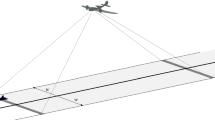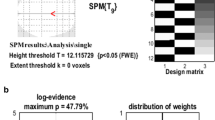Abstract
The Logan plot is a widely used algorithm for the quantitative analysis of neuroreceptors using PET because it is easy to use and simple to implement. The Logan plot is also suitable for receptor imaging because its algorithm is fast. However, use of the Logan plot, and interpretation of the formed receptor images should be regarded with caution, because noise in PET data causes bias in the Logan plot estimates. In this paper, we describe the basic concept of the Logan plot in detail and introduce three algorithms for the Logan plot. By comparing these algorithms, we demonstrate the pitfalls of the Logan plot and discuss the solution.
Similar content being viewed by others
References
Watabe H, Ikoma Y, Kimura Y, Naganawa M, Shidahara M. PET kinetic analysis—compartmental model.Ann Nucl Med 2006; 20 (9): 583–588.
Bard Y. The initial guess. InNonlinear Parameter Estimation; chapter 5–20. Academic Press, Inc., 1974: 120–123.
Logan J, Fowler JS, Volkow ND, Wolf AP, Dewey SL, Schlyer DJ, et al. Graphical analysis of reversible radioligand binding from time-activity measurements applied to [N-11C-methyl]-(−)-Cocaine PET studies in human subjects.J Cereb Blood Flow Metab 1990; 10 (10): 740–747.
Press WH, Teukolsky SA, Vetterling WT, Flannery BP. Fitting data to a straight line. InNumerical Recipies in C, Second Edition; chapter 15.2. Cambridge University Press, 1992; 661–666.
Mintun MA, Raichle ME, Kilbourn MR, Wooten GF, Welch MJ. A quantative model for thein vivo assessment of drug binding sites with positron emission tomography.Ann Neurol 1984; 15 (3): 217–227.
Koeppe RA, Holthoff VA, Frey KA, Kilbourn MR, Kuhl DE. Compartmental analysis of [11C] Flumazenil kinetics for the estimation of ligand transport rate and receptor distribution using positron emission tomography.J Cereb Blood Flow Metab 1991; 11 (5): 735–744.
Marquardt DW. An algorithm for least-square estimation of nonlinear parameters.J Soc Indust Appl Math 1963; 11 (2): 431–441.
Nelder LA, Mead R. A simplex method for function minimization.Computer J 1965; 7: 308–313.
Naganawa M, Kimura Y, Mishina M, Manabe Y, Chihara K, Oda K, et al. Quantification of adenosine A2A receptors in the human brain using [11C]TMSX and positron emission tomography.Eur J Nucl Med Mol Imaging 2006. DOI: 10.1007/s00259-006-0294-0.
Ishiwata K, Tsukada H, Kawamura K, Kimura Y, Nishiyama S, Kobayashi T, et al. Mapping of CNS sigma1 receptors in the conscious monkey: Preliminary PET study with [11C]SA4503.Synapse 2001; 40: 235–237.
Logan J. Graphical analysis of PET data applied to reversible and irreversible tracers.Nucl Med Biol 2000; 27: 661–670.
Varga J, Szabo Z. Modified regression model for the Logan plot.J Cereb Blood Flow Metab 2002; 22: 240–244.
Ogden RT. Estimation of kinetic parameters in graphical analysis of PET imaging data.Stat Med 2003; 22: 2557–2568.
Drapper NR, Smith H. Straight line regression when both variables are subject to error. InApplied regression analysis; chapter 3. 4. third edition. John Wiley & Sons, Inc., 1998: 89–96.
Slifstein M, Laruelle M. Effects of statistical noise on graphic analysis of PET neuroreceptor studies.J Nucl Med 2000; 41: 2083–2088.
Sakata M, Kimura Y, Naganawa M, Oda K, Ishii K, Chihara K, et al. Mapping of human cerebral sigma1 receptors using positron emission tomography and [11C]SA4503.NeuroImage 2006. DOI: 10. 1016/j.neuroimage.2006.11.055.
Logan J, Fowler JS, Volkow ND, Wang GJ, Ding YS, Alexoff DL. Distribution volume ratios without blood sampling from graphical analysis of PET data.J Cereb Blood Flow Metab 1996; 16 (5): 834–840.
Naganawa M, Kimura Y, Nariai T, Ishii K, Oda K, Manabe Y, et al. Omission of serial arterial blood sampling in neuroreceptor imaging with independent component analysis.NeuroImage 2005; 26 (3): 885–890.
Ichise M, Liow JS, Lu JQ, Takano A, Model K, Toyama H, et al. Linearized reference tissue parametric imaging methods: application to [11C]DASB positron emission tomography studies of the serotonin transporter in human brain.J Cereb Blood Flow Metab 2003; 23: 1096–1112.
Ichise M, Toyama H, Innis RB, Carson RE. Strategies to improve neuroreceptor parameter estimation by linear regression analysis.J Cereb Blood Flow Metab 2002; 22: 1271–1281.
Author information
Authors and Affiliations
Corresponding author
Rights and permissions
About this article
Cite this article
Kimura, Y., Naganawa, M., Shidahara, M. et al. PET kinetic analysis —Pitfalls and a solution for the Logan plot. Ann Nucl Med 21, 1–8 (2007). https://doi.org/10.1007/BF03033993
Received:
Revised:
Issue Date:
DOI: https://doi.org/10.1007/BF03033993




